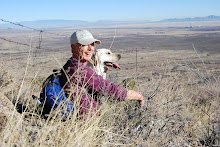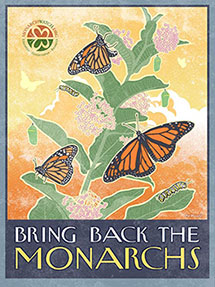We do not often take the time for a long and leisurely breakfast: most often we are out early on our bikes. In the spring the wind will blow, but in the mornings it is usually still so we take advantage and hope to beat the worst of it. But today we are Tired and need to take a day to recuperate (Coach says so).
While at the table we were being entertained by the birds at the feeders. Southeast Arizona is a great birding spot, The Big Year agrees. These are the birds we saw at and under the seed feeders: house finch (we have raised entire generations of them here), house sparrow (ditto), white-crowned sparrow, black- chinned sparrow, white-winged dove, mourning dove, Gambel's quail, scaled quail, cow bird, cactus wren (nesting on the porch), curve-billed thrasher (nesting on the side of the house), canyon towhee, black-headed grosbeak, blue grosbeak (a treat, and pictured below), lazuli bunting (a real treat, but too fast for the photographer), and pyrrhuloxia.
At the nectar feeders: Scott's oriole, hooded oriole, Bullock's oriole, black-chinned hummingbird, Costa's hummer.
And often found nearby, eyeing the feeders, but not today: greater road runner. Doing cleanup: the resident Harris' antelope ground squirrel family, and usually a bunny or two.
What a great place to live!
April 29, 2012
April 25, 2012
Garden, planted and armed ...,
... Check.
This year only half is planted for summer crops, the other half will be planted for winter vegetables.
This year only half is planted for summer crops, the other half will be planted for winter vegetables.
April 15, 2012
Nesting help
The year before last, curve-billed thrashers raised a family on top of the potting bench, under the eaves. It was a perfect place to nest as it was protected from the weather as well as from predators. The road runners took a lesson from that and evicted them from that spot last year, and raised 3 young ones. This year the thrashers tried to nest there again, but were driven out by the road runners who then abandoned the nest.
The thrashers moved to the east side of the house and tried to set up housekeeping in a small roosting box. I only noticed from the huge pile of sticks on the ground that had fallen from that little perch. Dan to the rescue. He build a good-sized platform, much like the potting bench roof spot, and it took only an hour for the birds to start stacking more wood. Their nests are mostly sticks, and mostly from the mesquites, very prickly. To each his own, of course.
Also last year, cactus wrens were not deterred by the smallness 2 other roosts on the porch, and raised 2 broods across from the kitchen window. It took those birds just a couple of days to stuff those roosting boxes and get to business. It was a real treat to see them care for the chicks so close up, and the parents kept the porch virtually insect free in feeding the entire family.
This year's pair of cactus wrens may be young, or let's just say, they are not experienced nest builders. They have tried for a couple of weeks to push nesting material into the roost, but when they flew out to gather more, most of the stuff fell out with them or was blown away by the wind. Again, Dan to the rescue. He build 2 magnificent condos because the cactus wrens build more than 1 nest and use other nests for roosting or raising subsequent families. This nest box is much bigger and hardware cloth keeps the nesting material from falling out. It also has holes on the sides for entry and exit. And we still have a great view of the nesting activities from the kitchen sink window. I just saw one of the wrens exit the nest after adding grass, twigs and dog hair. I think they approve!
Stay tuned for wren and thrasher family updates.
The thrashers moved to the east side of the house and tried to set up housekeeping in a small roosting box. I only noticed from the huge pile of sticks on the ground that had fallen from that little perch. Dan to the rescue. He build a good-sized platform, much like the potting bench roof spot, and it took only an hour for the birds to start stacking more wood. Their nests are mostly sticks, and mostly from the mesquites, very prickly. To each his own, of course.
Also last year, cactus wrens were not deterred by the smallness 2 other roosts on the porch, and raised 2 broods across from the kitchen window. It took those birds just a couple of days to stuff those roosting boxes and get to business. It was a real treat to see them care for the chicks so close up, and the parents kept the porch virtually insect free in feeding the entire family.
This year's pair of cactus wrens may be young, or let's just say, they are not experienced nest builders. They have tried for a couple of weeks to push nesting material into the roost, but when they flew out to gather more, most of the stuff fell out with them or was blown away by the wind. Again, Dan to the rescue. He build 2 magnificent condos because the cactus wrens build more than 1 nest and use other nests for roosting or raising subsequent families. This nest box is much bigger and hardware cloth keeps the nesting material from falling out. It also has holes on the sides for entry and exit. And we still have a great view of the nesting activities from the kitchen sink window. I just saw one of the wrens exit the nest after adding grass, twigs and dog hair. I think they approve!
Stay tuned for wren and thrasher family updates.
Frost in the middle of April
Lore in the valley says that when the mesquites leaf out, there will be no more freezing temperatures. Obviously, this is an urban (perhaps I should say "rural") legend. Mesquites have been leafing out for about a week, and yesterday we had a storm that brought 0.3" of moisture in the form of fat water at the WD, and as snow in the Chiricahuas, and last night it froze. Tomato, pepper, and cantaloupe plants were ferried from the cold frame to the garage.
Nonetheless, it is spring here today, and plants are blooming in the desert. Everything understated and low by the ground, but it's there if you look.
Two plants not so unobtrusive are the ocotillos, which are budding out to help out in the hummingbird migration, and the banana yuccas. Dan had told me that he had seen lots of yucca blooms, but when we went for a hike this morning most of them had already been eaten by the deer.
Temperatures are forecast to be in the upper 80's later this week. I must admit, I am looking forward to it.
Nonetheless, it is spring here today, and plants are blooming in the desert. Everything understated and low by the ground, but it's there if you look.
Two plants not so unobtrusive are the ocotillos, which are budding out to help out in the hummingbird migration, and the banana yuccas. Dan had told me that he had seen lots of yucca blooms, but when we went for a hike this morning most of them had already been eaten by the deer.
Temperatures are forecast to be in the upper 80's later this week. I must admit, I am looking forward to it.
Subscribe to:
Comments (Atom)
















